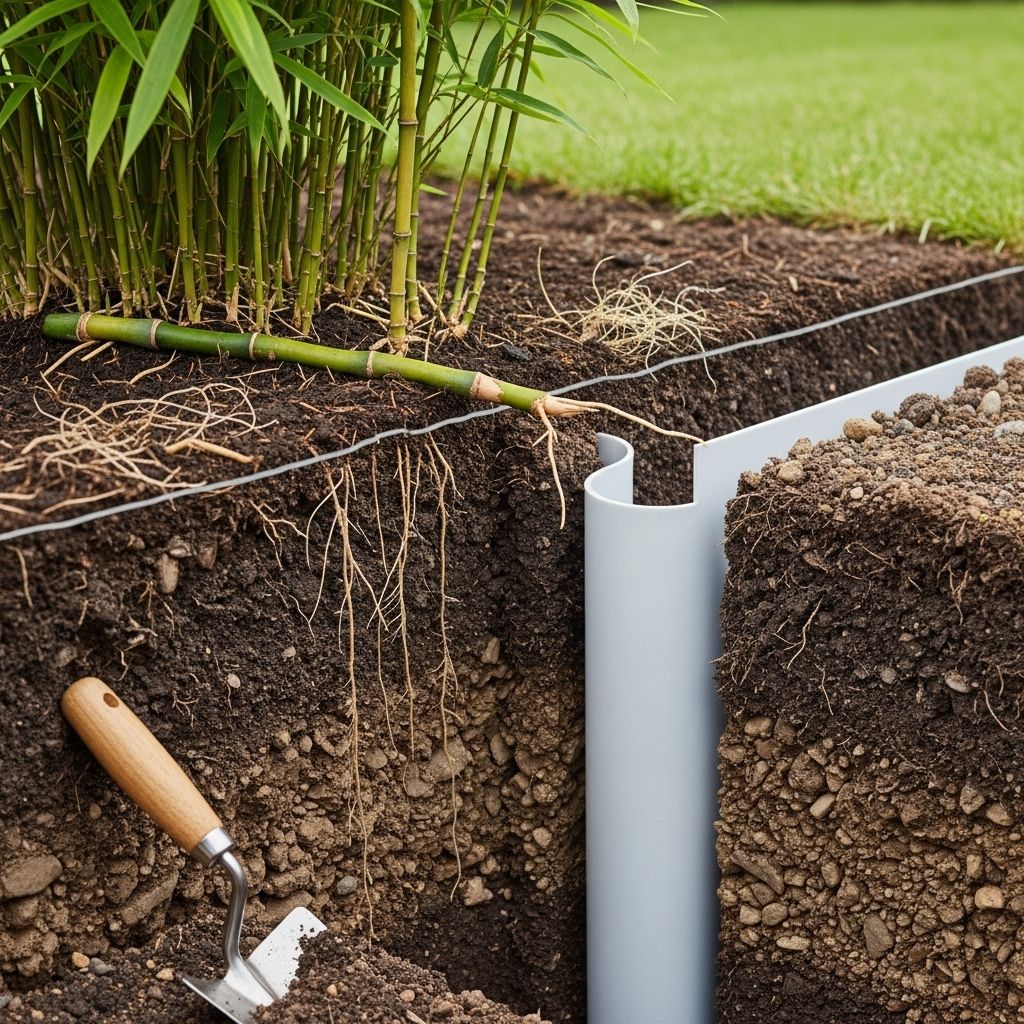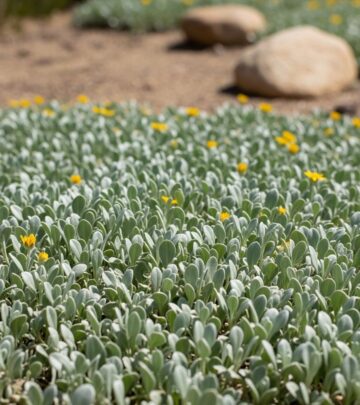Bamboo Barrier Installation: Guide To Containing Running Bamboo
Discover how to use bamboo barriers to control running bamboo, prevent invasive spread, and keep your garden healthy and beautiful.

Image: HearthJunction Design Team
Understanding Bamboo Barriers: A Complete Guide
Bamboo is prized for its rapid growth, aesthetic value, and sustainable qualities. But the same vigorous, spreading habit that makes bamboo attractive can also create persistent challenges for gardeners and property owners. Without adequate control, running bamboo species can escape garden boundaries and invade lawns, neighboring yards, or natural habitats. An effective bamboo barrier is the most reliable, eco-friendly method to contain bamboo and keep your landscape manageable.
Why Bamboo Needs Containment
Bamboo falls into two main categories: clumping and running types. Clumping bamboos grow in a tight circle and generally stay put, while running bamboos send out underground rhizomes—horizontal stems—that can stretch many feet per year. Unchecked, this growth habit enables bamboo to colonize vast areas, encroaching on nearby gardens and structures. While bamboo offers sustainability benefits and exceptional carbon sequestration, its invasive potential makes containment essential in most residential and landscaped settings.
What Is a Bamboo Barrier?
A bamboo barrier is a physical barricade, typically a flexible sheet made from high-density polyethylene (HDPE), installed in the soil around a bamboo planting. The barrier prevents the passage of rhizomes, redirecting them back toward the main bamboo clump and stopping unwanted spread. Installed correctly, a barrier gives gardeners control over bamboo’s underground runners, containing plants within a designated area while preserving their natural beauty and ecological value.
Benefits of Using Bamboo Barriers
- Prevents bamboo from spreading into lawns, gardens, and neighboring properties
- Offers a non-toxic, environmentally friendly alternative to chemical herbicides
- Reduces long-term maintenance and the need for disruptive root removal
- Maintains a healthy, balanced ecosystem by stopping domination by bamboo
- Allows gardeners to enjoy bamboo’s visual appeal without fear of invasion
- Cost-effective when compared to the expense of repairing bamboo-related property damage
Types of Bamboo Barriers
Bamboo containment barriers come in several materials and thicknesses. The right choice depends on your bamboo species, site specifics, and budget.
- High-Density Polyethylene (HDPE) Bamboo Barrier: This is the most commonly used material. HDPE is UV-resistant, flexible, and strong enough to block aggressive rhizomes. Typical thicknesses range from 30 to 100 mils (0.75 mm to 2.5 mm).
- Rubberized Barrier: Similar in function, rubberized barriers offer flexible installation and toughness but are less common due to higher cost and reduced availability.
- Metal Barriers: Thick sheet metal can block rhizomes but is difficult to work with, prone to rust, and rarely recommended for typical residential landscapes.
- Concrete or Masonry Walls: In some permanent installations, a solid foundation wall can contain bamboo, but this is more costly and labor-intensive than using flexible plastic barriers.
Most experts recommend a 60 mil HDPE bamboo barrier, which provides enough strength for most running bamboo species and offers good balance between durability, cost, and ease of installation.
How Bamboo Barriers Work
Bamboo rhizomes spread laterally underground, sometimes as shallow as 2–6 inches below the surface. The barrier’s purpose is to intercept these rhizomes. When a rhizome encounters the barrier, it is deflected and turns, following the edge of the barrier instead of breaking through. This creates a contained bamboo grove where all growth is controlled within a preset perimeter.
Planning Your Bamboo Barrier Installation
- Determine Placement: Plan the shape and size of your bamboo bed. The barrier should enclose the entire area where bamboo will be planted.
- Know Your Species: More vigorous and larger running bamboo species may require thicker barriers. Research the specific bamboo you wish to plant.
- Access and Maintenance: Leave enough space at the edge for periodic inspection and maintenance, if needed.
Step-by-Step: Installing a Bamboo Barrier
- Mark the Perimeter: Use string, garden hose, or marking chalk to create the boundary where your barrier will go. The barrier should form a continuous loop with no gaps.
- Dig a Trench: Excavate a trench around the perimeter, at least 24–30 inches (60–75 cm) deep, depending on the bamboo species and local climate. For running bamboo, 30 inches is standard.
- Place the Barrier: Insert the bamboo barrier vertically in the trench, leaving 2 inches (5 cm) above ground to stop rhizomes from jumping over the top. Overlap barrier ends by at least 2–3 feet (60–90 cm) if possible, and secure the overlap with stainless steel fasteners for a root-tight seal.
- Backfill: Fill the trench with soil, packing firmly to eliminate air pockets. The barrier should be tight against the soil to prevent rhizomes from sneaking between the barrier and the dirt.
- Inspect the Edge: Maintain 2 inches of the barrier above grade. This visible lip helps you spot and cut any rhizomes trying to scale the barrier.
| Barrier Type | Recommended Depth | Above-Ground Lip |
|---|---|---|
| HDPE (60 mil) | 28–30 inches | 2 inches |
| Rubberized | 24–30 inches | 2 inches |
| Metal | 24–28 inches | 2 inches |
After Installation: Caring for Contained Bamboo
Once your bamboo is planted and contained, maintenance is straightforward. However, to ensure the long-term effectiveness of the barrier, observe the following care tips:
- Inspect Annually: Walk the perimeter at least once a year. Check the above-ground lip for damage or exposure, and search for rhizomes attempting to breach or jump over the barrier.
- Cut Escaping Rhizomes: Any rhizomes that approach or crest the barrier should be cut back. Young rhizomes are easily clipped with loppers or a sharp spade.
- Monitor Soil Level: Mulch or shifting ground can cover the barrier’s top edge. Keep 2 inches exposed for visual checks.
- Repair Gaps Promptly: If you spot gaps or tears, repair using additional barrier material and waterproof tape or fasteners to maintain a seamless enclosure.
Alternative Bamboo Control Methods
Some gardeners opt for alternative methods, but these have their own limitations:
- Trenching: Create a trench around bamboo and cut rhizomes as they approach the edge. Effective but labor-intensive—requires monitoring multiple times each year.
- Physical Barriers from Other Materials: Concrete, brick, or even wooden borders can help but may rot, crack, or be breached over time by determined bamboo.
- Regular Rhizome Pruning: Manually digging around the bamboo clump to sever wandering rhizomes can contain spread, but is backbreaking and easily overlooked.
- Pots or Raised Containers: Suitable for smaller bamboo varieties or ornamental displays. Running bamboo may eventually outgrow even large containers if unchecked.
Bamboo barriers remain the most reliable and low-maintenance solution for most landscapes and gardens.
Choosing the Right Barrier for Your Garden
Consider the following when selecting the ideal bamboo barrier:
- Rhizome Strength: Larger, more aggressive bamboos require thicker, stronger barriers. A 60 mil HDPE is sufficient for most running types.
- Barrier Height: Deeper barriers provide better protection; most professionals recommend at least 28 inches deep, with thicker species demanding up to 36 inches.
- Installation Cost: HDPE barriers are cost-effective, while concrete or metal options increase up-front expense and installation labor.
- Longevity: Look for UV-resistant, durable materials for best performance over decades.
Frequently Asked Questions (FAQ)
How deep should a bamboo barrier be installed?
For most running bamboo, barriers should be installed at least 28–30 inches deep. If your soil is very loose or your bamboo is particularly aggressive, install the barrier deeper for maximum protection.
What happens if my barrier is not tall enough above ground?
If the barrier’s edge is buried or too low, bamboo rhizomes can climb over and escape. Always keep 2 inches of the barrier protruding above the soil and check regularly for debris buildup.
Is a bamboo barrier permanent?
High-quality HDPE barriers can last several decades underground. However, regular inspection and maintenance are necessary to ensure no breaches occur and the barrier remains functional.
Can I use bamboo barriers for other invasive plants?
Yes—bamboo barriers are effective against other rhizome-spreading plants such as certain grasses or horsetail. Always check plant habits and select appropriate barrier width and depth.
Are bamboo barriers environmentally friendly?
Yes. Bamboo barriers offer a chemical-free, physical method to contain plants and protect ecosystems. They help reduce the use of herbicides and minimize disruption to surrounding vegetation.
Best Practices for a Thriving Bamboo Grove
- Water bamboo regularly, especially in the first year after planting.
- Mulch generously to retain soil moisture and suppress weeds.
- Fertilize with a balanced, slow-release fertilizer in spring for vigorous, healthy canes.
- Thin out old, weak, or crowded canes to improve airflow and plant vigor.
- Monitor for pests or disease, especially in dense plantings.
Summary Table: Bamboo Barrier Quick Reference
| Feature | Best Practice |
|---|---|
| Barrier Material | HDPE (60 mil), UV-resistant |
| Trench Depth | 28–36 inches depending on bamboo |
| Above Ground Lip | 2 inches minimum |
| Barrier Overlap | 2–3 feet with strong fasteners |
| Inspection Frequency | Annually at minimum |
| Maintenance | Clip escaping rhizomes, repair damage promptly |
Conclusion: Responsible Bamboo Growing Made Simple
Bamboo barriers provide an elegant and eco-friendly way to enjoy the beauty and utility of bamboo without risking invasive growth. When chosen and installed correctly, barriers give gardeners peace of mind, simplify maintenance, and preserve biodiversity in your landscape. With proper planning, care, and routine inspection, your bamboo feature will thrive for decades—graceful, robust, and always within bounds.
References
Read full bio of medha deb












